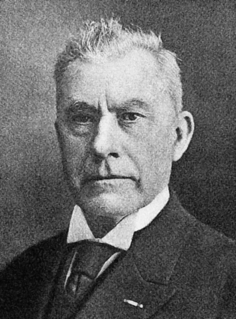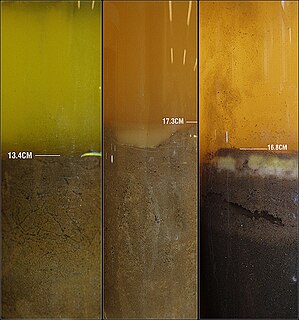Related Research Articles

Heinrich Hermann Robert Koch was a German physician and microbiologist. As one of the main founders of modern bacteriology, he identified the specific causative agents of tuberculosis, cholera, and anthrax and also gave experimental support for the concept of infectious disease, which included experiments on humans and animals. Koch created and improved laboratory technologies and techniques in the field of microbiology, and made key discoveries in public health. His research led to the creation of Koch's postulates, a series of four generalized principles linking specific microorganisms to specific diseases that proved influential on subsequent epidemiological principles such as the Bradford Hill criteria. For his research on tuberculosis, Koch received the Nobel Prize in Physiology or Medicine in 1905. The Robert Koch Institute is named in his honour.

A microorganism, or microbe, is a microscopic organism, which may exist in its single-celled form or a colony of cells.
An anaerobic organism or anaerobe is any organism that does not require oxygen for growth. It may react negatively or even die if free oxygen is present. In contrast, an aerobic organism (aerobe) is an organism that requires an oxygenated environment. Anaerobes may be unicellular or multicellular. Most fungi are obligate aerobes, requiring oxygen to survive, however some species, such as the Chytridiomycota that reside in the rumen of cattle, are obligate anaerobes; for these species, anaerobic respiration is used because oxygen will disrupt their metabolism or kill them.

Martinus Willem Beijerinck was a Dutch microbiologist and botanist who was one of the founders of virology and environmental microbiology. He is credited with the conceptual discovery of viruses, which he called Contagium vivum fluidum.

An agar plate is a Petri dish that contains agar as a solid growth medium plus nutrients, used to culture microorganisms. Sometimes selective compounds are added to influence growth, such as antibiotics.

Bacteriological water analysis is a method of analysing water to estimate the numbers of bacteria present and, if needed, to find out what sort of bacteria they are. It represents one aspect of water quality. It is a microbiological analytical procedure which uses samples of water and from these samples determines the concentration of bacteria. It is then possible to draw inferences about the suitability of the water for use from these concentrations. This process is used, for example, to routinely confirm that water is safe for human consumption or that bathing and recreational waters are safe to use.

Microbial ecology is the ecology of microorganisms: their relationship with one another and with their environment. It concerns the three major domains of life—Eukaryota, Archaea, and Bacteria—as well as viruses.

A blood culture is a medical laboratory test used to detect bacteria or fungi in a person's blood. Blood is normally sterile, and the presence of microbes in the blood can indicate a bloodstream infection such as bacteremia or fungemia, which in severe cases may result in sepsis. By culturing the blood, microbes can be identified and tested for resistance to antimicrobial drugs, which allows clinicians to provide an effective treatment.

A growth medium or culture medium is a solid, liquid or semi-solid designed to support the growth of a population of microorganisms or cells via the process of cell proliferation, or small plants like the moss Physcomitrella patens. Different types of media are used for growing different types of cells.

Sergei Nikolaievich Winogradsky was a Russian microbiologist, ecologist and soil scientist who pioneered the cycle-of-life concept.

The Winogradsky column is a simple device for culturing a large diversity of microorganisms. Invented in the 1880s by Sergei Winogradsky, the device is a column of pond mud and water mixed with a carbon source such as newspaper, blackened marshmallows or egg-shells, and a sulfur source such as gypsum or egg yolk. Incubating the column in sunlight for months results in an aerobic/anaerobic gradient as well as a sulfide gradient. These two gradients promote the growth of different microorganisms such as Clostridium, Desulfovibrio, Chlorobium, Chromatium, Rhodomicrobium, and Beggiatoa, as well as many other species of bacteria, cyanobacteria, and algae.

In microbiology, streaking is a technique used to isolate a pure strain from a single species of microorganism, often bacteria. Samples can then be taken from the resulting colonies and a microbiological culture can be grown on a new plate so that the organism can be identified, studied, or tested.

Brain heart infusion (BHI) is a growth medium for growing microorganisms. It is a nutrient-rich medium, and can therefore be used to culture a variety of fastidious organisms. In particular, it has been used to culture streptococci, pneumococci and meningococci, which can be otherwise challenging to grow. BHI is made by combining an infusion from boiled bovine or porcine heart and brain with a variety of other nutrients. BHI broth is often used in food safety, water safety, and antibiotic sensitivity tests.

Sabouraud agar or Sabouraud dextrose agar (SDA) is a type of agar growth medium containing peptones. It is used to cultivate dermatophytes and other types of fungi, and can also grow filamentous bacteria such as Nocardia. It has utility for research and clinical care.

Microbiology is the study of microorganisms, those being unicellular, multicellular, or acellular. Microbiology encompasses numerous sub-disciplines including virology, bacteriology, protistology, mycology, immunology and parasitology.
Mycobacteria Growth Indicator Tube (MGIT) is intended for the detection and recovery of mycobacteria. The MGIT Mycobacteria Growth Indicator Tube contains 7 mL of modified Middlebrook 7H9 Broth base. The complete medium, with OADC enrichment and PANTA antibiotic mixture, is one of the most commonly used liquid media for the cultivation of mycobacteria.

Granada medium is a selective and differential culture medium designed to selectively isolate Streptococcus agalactiae and differentiate it from other microorganisms. Granada Medium was developed by Dr. Manuel Rosa-Fraile et al. at the Service of Microbiology in the Hospital Virgen de las Nieves in Granada (Spain).
In microbiology, the term isolation refers to the separation of a strain from a natural, mixed population of living microbes, as present in the environment, for example in water or soil flora, or from living beings with skin flora, oral flora or gut flora, in order to identify the microbe(s) of interest. Historically, the laboratory techniques of isolation first developed in the field of bacteriology and parasitology, before those in virology during the 20th century. Methods of microbial isolation have drastically changed over the past 50 years, from a labor perspective with increasing mechanization, and in regard to the technology involved, and hence speed and accuracy.
Diagnostic microbiology is the study of microbial identification. Since the discovery of the germ theory of disease, scientists have been finding ways to harvest specific organisms. Using methods such as differential media or genome sequencing, physicians and scientists can observe novel functions in organisms for more effective and accurate diagnosis of organisms. Methods used in diagnostic microbiology are often used to take advantage of a particular difference in organisms and attain information about what species it can be identified as, which is often through a reference of previous studies. New studies provide information that others can reference so that scientists can attain a basic understanding of the organism they are examining.

Vasily Leonidovich Omelianski was a Russian microbiologist and author of the first original Russian text book on microbiology. He was the only student of Sergei Winogradsky and succeeded him as head of the department of General Microbiology at the Institute of Experimental Medicine in Saint Petersburg.
References
- ↑ Schlegel, Hans G. (1995). General microbiology (7 ed.). Cambridge: Cambridge Univ. Press. pp. 204–205. ISBN 978-0521439800.
- ↑ Tortora, Gerard J., Berdell R. Funke, and Christine L. Case. (2014). "Microbioligy: An Introduction" 12e. New York City, New York: Pearson Education. // 161.
- ↑ Beijerinck, Martinus W. (1901). "Anhaufungsversuche mit Ureumbakterien". Centralblatt F. Bakteriologie, II. 7: 33–61.
- ↑ Winogradsky, Sergei (1890). "Sur les organismes de la nitrification". Comptes rendus de l'Académie des sciences. 110: 1013–1016.
- ↑ "Product Center: Alkaline Peptone Water (for Vibrio), 8 mL" . Retrieved 28 August 2012.
| This microbiology-related article is a stub. You can help Wikipedia by expanding it. |